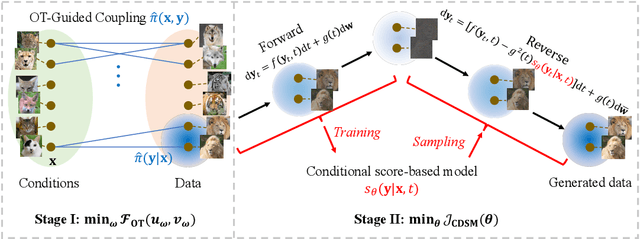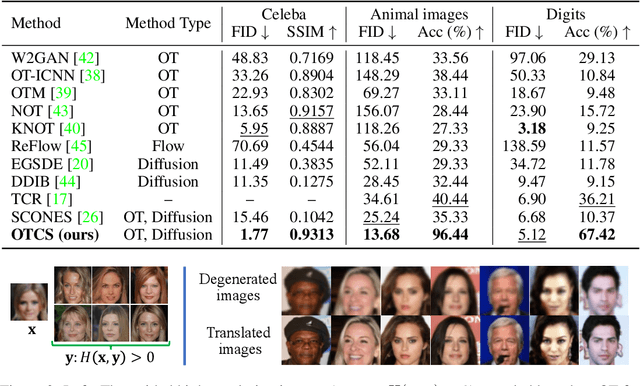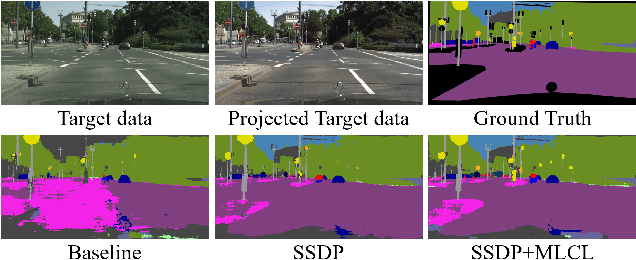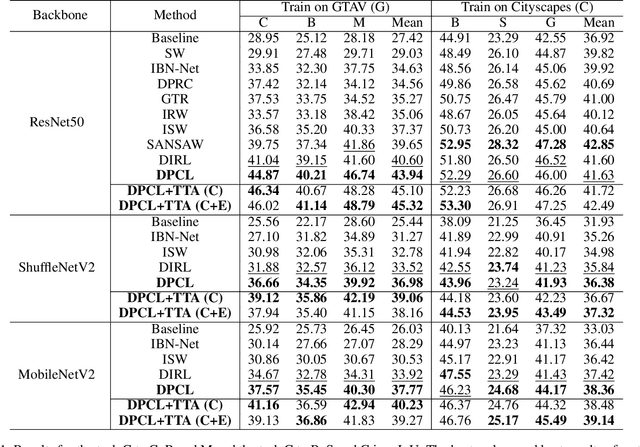Xiang Gu
GMapLatent: Geometric Mapping in Latent Space
Mar 30, 2025Abstract:Cross-domain generative models based on encoder-decoder AI architectures have attracted much attention in generating realistic images, where domain alignment is crucial for generation accuracy. Domain alignment methods usually deal directly with the initial distribution; however, mismatched or mixed clusters can lead to mode collapse and mixture problems in the decoder, compromising model generalization capabilities. In this work, we innovate a cross-domain alignment and generation model that introduces a canonical latent space representation based on geometric mapping to align the cross-domain latent spaces in a rigorous and precise manner, thus avoiding mode collapse and mixture in the encoder-decoder generation architectures. We name this model GMapLatent. The core of the method is to seamlessly align latent spaces with strict cluster correspondence constraints using the canonical parameterizations of cluster-decorated latent spaces. We first (1) transform the latent space to a canonical parameter domain by composing barycenter translation, optimal transport merging and constrained harmonic mapping, and then (2) compute geometric registration with cluster constraints over the canonical parameter domains. This process realizes a bijective (one-to-one and onto) mapping between newly transformed latent spaces and generates a precise alignment of cluster pairs. Cross-domain generation is then achieved through the aligned latent spaces embedded in the encoder-decoder pipeline. Experiments on gray-scale and color images validate the efficiency, efficacy and applicability of GMapLatent, and demonstrate that the proposed model has superior performance over existing models.
Degradation-Aware Residual-Conditioned Optimal Transport for Unified Image Restoration
Nov 03, 2024



Abstract:All-in-one image restoration has emerged as a practical and promising low-level vision task for real-world applications. In this context, the key issue lies in how to deal with different types of degraded images simultaneously. In this work, we present a Degradation-Aware Residual-Conditioned Optimal Transport (DA-RCOT) approach that models (all-in-one) image restoration as an optimal transport (OT) problem for unpaired and paired settings, introducing the transport residual as a degradation-specific cue for both the transport cost and the transport map. Specifically, we formalize image restoration with a residual-guided OT objective by exploiting the degradation-specific patterns of the Fourier residual in the transport cost. More crucially, we design the transport map for restoration as a two-pass DA-RCOT map, in which the transport residual is computed in the first pass and then encoded as multi-scale residual embeddings to condition the second-pass restoration. This conditioning process injects intrinsic degradation knowledge (e.g., degradation type and level) and structural information from the multi-scale residual embeddings into the OT map, which thereby can dynamically adjust its behaviors for all-in-one restoration. Extensive experiments across five degradations demonstrate the favorable performance of DA-RCOT as compared to state-of-the-art methods, in terms of distortion measures, perceptual quality, and image structure preservation. Notably, DA-RCOT delivers superior adaptability to real-world scenarios even with multiple degradations and shows distinctive robustness to both degradation levels and the number of degradations.
Prototypical Partial Optimal Transport for Universal Domain Adaptation
Aug 02, 2024Abstract:Universal domain adaptation (UniDA) aims to transfer knowledge from a labeled source domain to an unlabeled target domain without requiring the same label sets of both domains. The existence of domain and category shift makes the task challenging and requires us to distinguish "known" samples (i.e., samples whose labels exist in both domains) and "unknown" samples (i.e., samples whose labels exist in only one domain) in both domains before reducing the domain gap. In this paper, we consider the problem from the point of view of distribution matching which we only need to align two distributions partially. A novel approach, dubbed mini-batch Prototypical Partial Optimal Transport (m-PPOT), is proposed to conduct partial distribution alignment for UniDA. In training phase, besides minimizing m-PPOT, we also leverage the transport plan of m-PPOT to reweight source prototypes and target samples, and design reweighted entropy loss and reweighted cross-entropy loss to distinguish "known" and "unknown" samples. Experiments on four benchmarks show that our method outperforms the previous state-of-the-art UniDA methods.
Residual-Conditioned Optimal Transport: Towards Structure-preserving Unpaired and Paired Image Restoration
May 05, 2024



Abstract:Deep learning-based image restoration methods have achieved promising performance. However, how to faithfully preserve the structure of the original image remains challenging. To address this challenge, we propose a novel Residual-Conditioned Optimal Transport (RCOT) approach, which models the image restoration as an optimal transport (OT) problem for both unpaired and paired settings, integrating the transport residual as a unique degradation-specific cue for both the transport cost and the transport map. Specifically, we first formalize a Fourier residual-guided OT objective by incorporating the degradation-specific information of the residual into the transport cost. Based on the dual form of the OT formulation, we design the transport map as a two-pass RCOT map that comprises a base model and a refinement process, in which the transport residual is computed by the base model in the first pass and then encoded as a degradation-specific embedding to condition the second-pass restoration. By duality, the RCOT problem is transformed into a minimax optimization problem, which can be solved by adversarially training neural networks. Extensive experiments on multiple restoration tasks show the effectiveness of our approach in terms of both distortion measures and perceptual quality. Particularly, RCOT restores images with more faithful structural details compared to state-of-the-art methods.
Adversarial Reweighting with $α$-Power Maximization for Domain Adaptation
Apr 26, 2024Abstract:The practical Domain Adaptation (DA) tasks, e.g., Partial DA (PDA), open-set DA, universal DA, and test-time adaptation, have gained increasing attention in the machine learning community. In this paper, we propose a novel approach, dubbed Adversarial Reweighting with $\alpha$-Power Maximization (ARPM), for PDA where the source domain contains private classes absent in target domain. In ARPM, we propose a novel adversarial reweighting model that adversarially learns to reweight source domain data to identify source-private class samples by assigning smaller weights to them, for mitigating potential negative transfer. Based on the adversarial reweighting, we train the transferable recognition model on the reweighted source distribution to be able to classify common class data. To reduce the prediction uncertainty of the recognition model on the target domain for PDA, we present an $\alpha$-power maximization mechanism in ARPM, which enriches the family of losses for reducing the prediction uncertainty for PDA. Extensive experimental results on five PDA benchmarks, i.e., Office-31, Office-Home, VisDA-2017, ImageNet-Caltech, and DomainNet, show that our method is superior to recent PDA methods. Ablation studies also confirm the effectiveness of components in our approach. To theoretically analyze our method, we deduce an upper bound of target domain expected error for PDA, which is approximately minimized in our approach. We further extend ARPM to open-set DA, universal DA, and test time adaptation, and verify the usefulness through experiments.
Optimal Transport-Guided Conditional Score-Based Diffusion Models
Nov 02, 2023



Abstract:Conditional score-based diffusion model (SBDM) is for conditional generation of target data with paired data as condition, and has achieved great success in image translation. However, it requires the paired data as condition, and there would be insufficient paired data provided in real-world applications. To tackle the applications with partially paired or even unpaired dataset, we propose a novel Optimal Transport-guided Conditional Score-based diffusion model (OTCS) in this paper. We build the coupling relationship for the unpaired or partially paired dataset based on $L_2$-regularized unsupervised or semi-supervised optimal transport, respectively. Based on the coupling relationship, we develop the objective for training the conditional score-based model for unpaired or partially paired settings, which is based on a reformulation and generalization of the conditional SBDM for paired setting. With the estimated coupling relationship, we effectively train the conditional score-based model by designing a ``resampling-by-compatibility'' strategy to choose the sampled data with high compatibility as guidance. Extensive experiments on unpaired super-resolution and semi-paired image-to-image translation demonstrated the effectiveness of the proposed OTCS model. From the viewpoint of optimal transport, OTCS provides an approach to transport data across distributions, which is a challenge for OT on large-scale datasets. We theoretically prove that OTCS realizes the data transport in OT with a theoretical bound. Code is available at \url{https://github.com/XJTU-XGU/OTCS}.
Keypoint-Guided Optimal Transport
Mar 23, 2023Abstract:Existing Optimal Transport (OT) methods mainly derive the optimal transport plan/matching under the criterion of transport cost/distance minimization, which may cause incorrect matching in some cases. In many applications, annotating a few matched keypoints across domains is reasonable or even effortless in annotation burden. It is valuable to investigate how to leverage the annotated keypoints to guide the correct matching in OT. In this paper, we propose a novel KeyPoint-Guided model by ReLation preservation (KPG-RL) that searches for the optimal matching (i.e., transport plan) guided by the keypoints in OT. To impose the keypoints in OT, first, we propose a mask-based constraint of the transport plan that preserves the matching of keypoint pairs. Second, we propose to preserve the relation of each data point to the keypoints to guide the matching. The proposed KPG-RL model can be solved by Sinkhorn's algorithm and is applicable even when distributions are supported in different spaces. We further utilize the relation preservation constraint in the Kantorovich Problem and Gromov-Wasserstein model to impose the guidance of keypoints in them. Meanwhile, the proposed KPG-RL model is extended to the partial OT setting. Moreover, we deduce the dual formulation of the KPG-RL model, which is solved using deep learning techniques. Based on the learned transport plan from dual KPG-RL, we propose a novel manifold barycentric projection to transport source data to the target domain. As applications, we apply the proposed KPG-RL model to the heterogeneous domain adaptation and image-to-image translation. Experiments verified the effectiveness of the proposed approach.
Spherical Space Feature Decomposition for Guided Depth Map Super-Resolution
Mar 15, 2023



Abstract:Guided depth map super-resolution (GDSR), as a hot topic in multi-modal image processing, aims to upsample low-resolution (LR) depth maps with additional information involved in high-resolution (HR) RGB images from the same scene. The critical step of this task is to effectively extract domain-shared and domain-private RGB/depth features. In addition, three detailed issues, namely blurry edges, noisy surfaces, and over-transferred RGB texture, need to be addressed. In this paper, we propose the Spherical Space feature Decomposition Network (SSDNet) to solve the above issues. To better model cross-modality features, Restormer block-based RGB/depth encoders are employed for extracting local-global features. Then, the extracted features are mapped to the spherical space to complete the separation of private features and the alignment of shared features. Shared features of RGB are fused with the depth features to complete the GDSR task. Subsequently, a spherical contrast refinement (SCR) module is proposed to further address the detail issues. Patches that are classified according to imperfect categories are input to the SCR module, where the patch features are pulled closer to the ground truth and pushed away from the corresponding imperfect samples in the spherical feature space via contrastive learning. Extensive experiments demonstrate that our method can achieve state-of-the-art results on four test datasets and can successfully generalize to real-world scenes. Code will be released.
Generalized Semantic Segmentation by Self-Supervised Source Domain Projection and Multi-Level Contrastive Learning
Mar 03, 2023



Abstract:Deep networks trained on the source domain show degraded performance when tested on unseen target domain data. To enhance the model's generalization ability, most existing domain generalization methods learn domain invariant features by suppressing domain sensitive features. Different from them, we propose a Domain Projection and Contrastive Learning (DPCL) approach for generalized semantic segmentation, which includes two modules: Self-supervised Source Domain Projection (SSDP) and Multi-level Contrastive Learning (MLCL). SSDP aims to reduce domain gap by projecting data to the source domain, while MLCL is a learning scheme to learn discriminative and generalizable features on the projected data. During test time, we first project the target data by SSDP to mitigate domain shift, then generate the segmentation results by the learned segmentation network based on MLCL. At test time, we can update the projected data by minimizing our proposed pixel-to-pixel contrastive loss to obtain better results. Extensive experiments for semantic segmentation demonstrate the favorable generalization capability of our method on benchmark datasets.
Should All Temporal Difference Learning Use Emphasis?
Mar 01, 2019



Abstract:Emphatic Temporal Difference (ETD) learning has recently been proposed as a convergent off-policy learning method. ETD was proposed mainly to address convergence issues of conventional Temporal Difference (TD) learning under off-policy training but it is different from conventional TD learning even under on-policy training. A simple counterexample provided back in 2017 pointed to a potential class of problems where ETD converges but TD diverges. In this paper, we empirically show that ETD converges on a few other well-known on-policy experiments whereas TD either diverges or performs poorly. We also show that ETD outperforms TD on the mountain car prediction problem. Our results, together with a similar pattern observed under off-policy training in prior works, suggest that ETD might be a good substitute over conventional TD.
 Add to Chrome
Add to Chrome Add to Firefox
Add to Firefox Add to Edge
Add to Edge